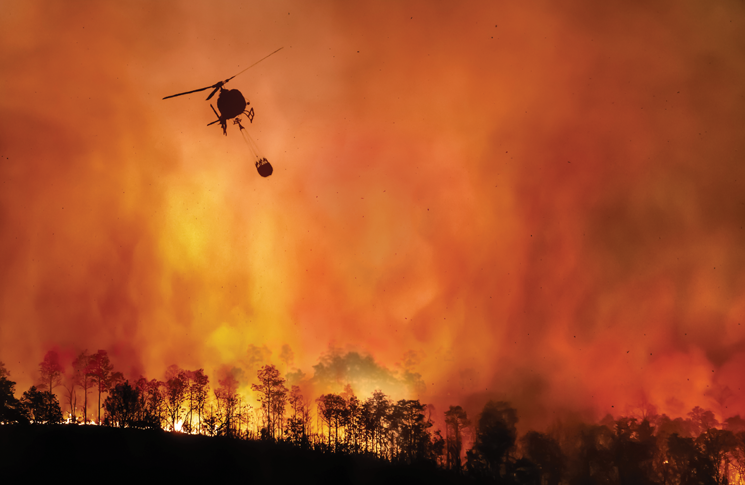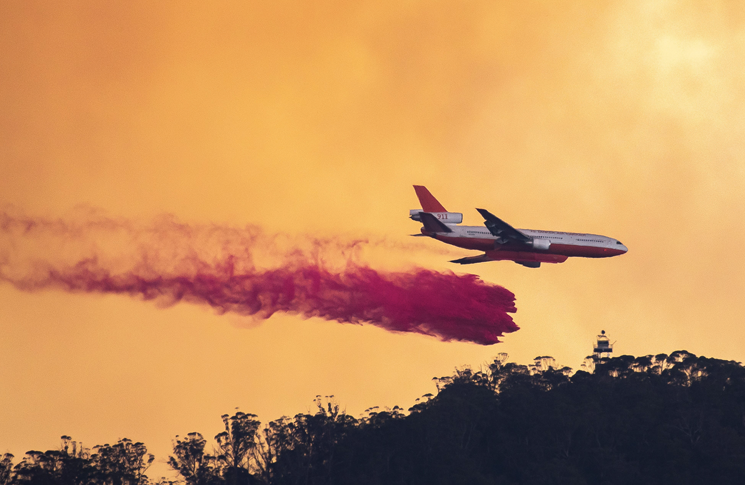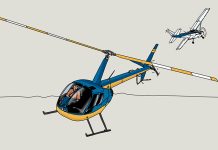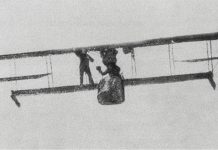Operators of firefighting aircraft have to adapt to the emerging hazards of larger and more widespread fires
In 2019–20 Australia burned in fires that stretched from Queensland to Tasmania and South Australia. The bushfires of that long hot season burnt an estimated 186,000 square km, destroyed more than 5900 buildings (including 2779 homes) and killed 34 people. In NSW there were active bushfires every day between July 2019 and 4 March 2020.
Aerial firefighting played a central role in fighting the fires. The Australian Transport Safety Bureau (ATSB) estimated there were 4 times as many hours flown in the ‘black summer’ – as 2019–20 came to be known – than in a typical recent season. Three aircraft crashed during the effort: 2 helicopters, whose pilots escaped with minor injuries, and a large air tanker, whose crash also killed its 3 crew. Additionally, 3 firefighters on the ground were killed in truck accidents directly caused by severe bushfire conditions.
As part of the official inquiry into the fires, the ATSB was commissioned to report on aerial firefighting safety occurrences. It found there had been more reported safety occurrences involving aerial firefighting aircraft in Australia in the financial year covering the 2019–20 bushfire season, than any financial year since July 2000. In addition, there had been 2 fatal accidents since August 2018, whereas the previous 17 years only had 3 fatal accidents. And the number of occurrences per financial year increased steadily since 2016–17.
However, the ATSB cautioned these figures did not necessarily mean aerial firefighting was becoming more dangerous. ‘Given the increased activity, these results could be expected and probably do not indicate a significant increase in the risk per flight,’ the bureau said.
Reassuring news about the rate of accidents can coexist with an increasing number of accidents when activity is increasing.
A 500-hour annual season
on a firefighting aircraft
is regarded as equivalent to
3500 hours in regular use.
National Aerial Firefighting centre chief executive Stuart Ellis says aircraft are now regarded as a mainstream, first response firefighting method.
‘Aerial firefighting is now seen as part of the holistic firefighting effort from the time the fire is reported,’ he says. ‘There is a key focus on hitting the fire as soon as it is identified.
In South Australia the policy has been for some years that aircraft are dispatched as soon as a fire is identified. That approach has been adopted in Victoria and NSW.’
New hazards
Founder of Kestrel aviation and president of the Australian Helicopter Industry Association Ray Cronin says there was a subtle build-up to the catastrophic 2019–20 fire season that should have been seen as a warning.
‘In the seasons leading up to 2019–20, there was much more aggressive environmental behaviour. In some more intense fires, you’d see branches flying through the air, not just leaves,’ Cronin says.
‘You could see the seasons were getting longer, the fire behaviour getting more aggressive. But it was subtle. The naysayers were happy because there were enough quiet periods for them to say it wasn’t global warming. There were indicators, but you couldn’t pin the tail on the donkey. Then the 19–20 season just blew everyone’s mind.’
Among the factors that gave the fires of 2019–20 an apocalyptic character was the cloud they produced. The flames created huge billowing clouds known technically as pyrocumulonimbus or flammagenitus – and popularly as pyrocumulus.
These towering clouds arise from a combination of heating and cooling. They begin when intense heat from the fire causes air to rise rapidly in the smoke plume. The rising hot air is turbulent and draws in cooler air, which cools the plume as it rises. As the plume rises to high altitudes, the atmospheric pressure reduces, causing the plume air to expand and cool even further. If it cools enough, the moisture in the plume air will condense and forms a cumulus cloud. The condensation process releases latent heat, which makes the cloud warmer, further energising its climb, in another cycle of expansion and cooling. The process may go on until the cloud top reaches the lower stratosphere before losing buoyancy. Meanwhile, collisions of ice particles in the very cold upper parts of these clouds cause a build-up of electrical charge, which is released by giant sparks – lightning. A thunderstorm results, which may start further bushfires. This happened 100 km ahead of the fire front in the Black Saturday fires of 2009.
Pyrocumulus clouds were once regarded as rarities but the summer of 2019–20 saw a ‘near doubling of the record of these events, in one event’, Professor David Bowman from the University of Tasmania told the 2020 Bushfire Royal Commission.
‘So something happened this last summer which is truly extraordinary, because, what we would call statistically a black swan event, we saw a flock of black swans,’ Bowman, professor of pyrogeography and fire science, said. ‘That just shouldn’t have happened.”
Ellis agrees. ‘I was involved in a review of the Canberra bushfires of 2003 and it was one of the first times we’d even identified pyrocumulus as an issue. Now it’s a matter of how many, at which fires and how large they are,’ he says. ‘It’s a factor that directly impacts on aerial firefighting because it’s a major issue for anyone in the air.’
John Gallaher, director of fixed-wing flight operations with US aerial firefighter Coulson Aviation, says pyrocumulus clouds are not a new phenomenon. ‘I remember 20 years ago being round fires with these columns,’ he says. ‘The challenge for firefighters is the unstable air mass associated with it. Fortunately, unlike an airmass with no smoke, you get a very clear picture of what the air is doing – all you have to do is look at the smoke. You know where you can operate and where you have to stay away from.’
There is great potential to use aerial firefighting at night when generally the fires are milder.
Rain from pyrocumulus clouds produces intense downbursts that hit the ground and expand outwards, producing very strong and gusty winds that can last 20 minutes or more.
Very large and hot fires interact with the earth’s rotation and local winds to produce spinning fires. These occur in 3 types:
- Fire whirls – small, thin and transient disturbances than can nevertheless reach hundreds of metres into the air
- Fire-generated tornadoes – larger, stronger and longer-lasting than
fire-whirls - Supercell bushfire thunderstorms – when a pyrocumulus system spins, generating horizontal winds and turbulence in association with downdrafts.
Gallaher says extreme fire-related weather makes fires difficult and sometimes impossible to control. ‘There are times when you have to say, “All right – there’s nothing more we can do”,’ he says. ‘When a fire gets to burning with swirls, tornados and thunderstorms, typically the firefighters both on the ground and in the air have given up on direct attack of the fire.’
It becomes hard to fly an accurate flightpath. ‘Usually, you can get close but with the unstable air and the smoke column, there’s no way to get the product onto the ground.’ The emphasis changes to retardant drops on the green side of firebreaks, which may be open spaces, roads, railways or bulldozed scrapes in the earth.
Cronin says the sheer size of the 2019–20 fires meant logistic support emerged as an issue like never before. ‘There were so many people out in the field that all the motels were filling up – you couldn’t get near aircraft and there were road closures all along the east coast. We ended up chartering aircraft to fly people and parts around because we couldn’t move anything on the ground.’

Fatigue and COVID
Fatigue is a fact of life in managing firefighting. Longer fire seasons exacerbate the problem, and the restrictions associated with the COVID-19 pandemic add another layer of complexity.
‘Managing crew rotation becomes extremely complicated when the problem is finding experienced crews, respecting fatigue limits and adhering to quarantine,’ Ellis says. ‘A lot of overseas operators would plan to change crews during a long season. That’s much harder now.’ Just sending aircraft to Western Australia in February 2020 was far from straightforward, requiring permission from police commissioners and establishing bubble accommodation to isolate crew.
Cronin says the size and duration of the 2019–20 fires introduced a new dimension of fatigue. ‘There was a greater concentration of aircraft on one area, there were aircraft performance issues because of high temperatures, there was thick smoke. And it was consistent – not smoke one day and clear the next. That introduced a level of fatigue and frustration in crews, both in the air and on the ground.
‘In a season like that, you’ve got to be really careful with your people. Fatigue goes right through the whole camp, not just the people at the coalface.’
Gallaher says fatigue is a problem for crews and aircraft alike. ‘We have duty days and flight time limits, and we run our crews on a schedule that is designed to keep them from being worn out,’ he says.
The stress of firefighting operations also extracts a heavy toll on aircraft.
‘In any given season, an aircraft can be flying every day,’ Gallaher says. ‘Routine maintenance becomes a challenge when you’re flying that much, but fatigue is the factor that limits aircraft lifespan.’ Over 7 decades of aerial firefighting in the US, crashes related to structural failure have taught operators to be conservative in aircraft loading and operations and generous in calculating stress-adjusted airframe hours. ‘In our business one airframe hour may count for as many as seven hours,’ Gallaher says.
We’ve quit talking about
fire seasons and just talk
about fire years.
Aerial firefighting involves low-level operations in rough turbulent air, with frequent take-off and landing cycles, at medium to high gross weight, even though these are conservatively calculated, with wide operating margins. Smoke is a wild card in this scenario. ‘There really hasn’t been a lot of track history on operating turbine engines around fire and its effect on the engines,’ Gallaher says. ‘We don’t fly through dense smoke but I can’t say we never encounter smoke.’
The result is that a 500-hour annual season on a firefighting aircraft is regarded as equivalent to 3500 hours in regular use. ‘The C-130 Hercules we acquired were very low-time to start with,’ Gallaher says.
New techniques
Night operations
During early 2018, Emergency Management Victoria conducted a trial of night firebombing using night‑vision goggle equipped helicopters around Ballarat in Victoria.
The trial demonstrated that night firebombing could be practical and effective. ‘There is great potential to use aerial firefighting at night when generally the fires are milder,’ Ellis says, ‘although that wasn’t always the case in 19–20.’
The all-out effort of the 2019–20 season interrupted the development of night firefighting, Ellis says. ‘It’s not a mature capability at the current time’, but interest after the promising Victorian trial remains high.
‘Night offers the chance to take advantage of favourable conditions of lower temperature and higher relative humidity. And if we’ve got the airframes, it makes sense to maximise use of them.’
Large aircraft
There is also a trend towards using larger aircraft earlier in the fire. ‘Some jurisdictions are now exploring whether we can engage large air tankers earlier to have a focused approach of attacking fires when they’re small, with large air tankers, not just smaller aircraft,’ Ellis says.
Although 81 per cent of the aerial firefighting fleet is Australian owned and registered, most large helicopters and very large aircraft are mostly contracted from the northern hemisphere (although NSW now own and operates a Boeing 737 large air tanker). This situation creates the issue of fire season overlap – contracted aircraft are often now busy fighting late season northern hemisphere fires at the same time as early season fires are underway in Australia.
‘Let me put it this way: we’ve quit talking about fire seasons and just talk about fire years, Gallaher says. ‘In North America we now have years where there are fires year-round. There’s no question that fire seasons are getting longer and there is overlap between here and Australia. The 19–20 season started in August, at the height of the north American season, there was lot of overlap.’
But he is confident the market will respond to increased demand in both hemispheres at the same time. ‘I don’t think it’s an insurmountable issue, but it’s one we need a keen focus on.’
Gallaher says large air tankers can play a significant role in fighting Australian fires that are far from the nearest aerodrome. ‘One of the challenges Australia faces is the distance fires are from airports set up for firefighting operations [with tank refilling facilities],’ he says. ‘The farther the distance, the slower the turnaround. You get a fire that’s far away and the single-engine air tankers become less efficient, because they are slower and not carrying as much volume. This is balanced to some degree by the ability of single-engine air tankers
to land in paddocks or smaller airfields and draw water/retardant from tanker trucks.’
Gallaher and Ellis agree that a balanced aerial firefighting fleet requires a mix of large and small aircraft, both fixed-wing and rotary to support ground-based firefighters. ‘It’s all about the volume you put on the fire, whether from a few large aircraft or many smaller aircraft,’ Gallaher says.





